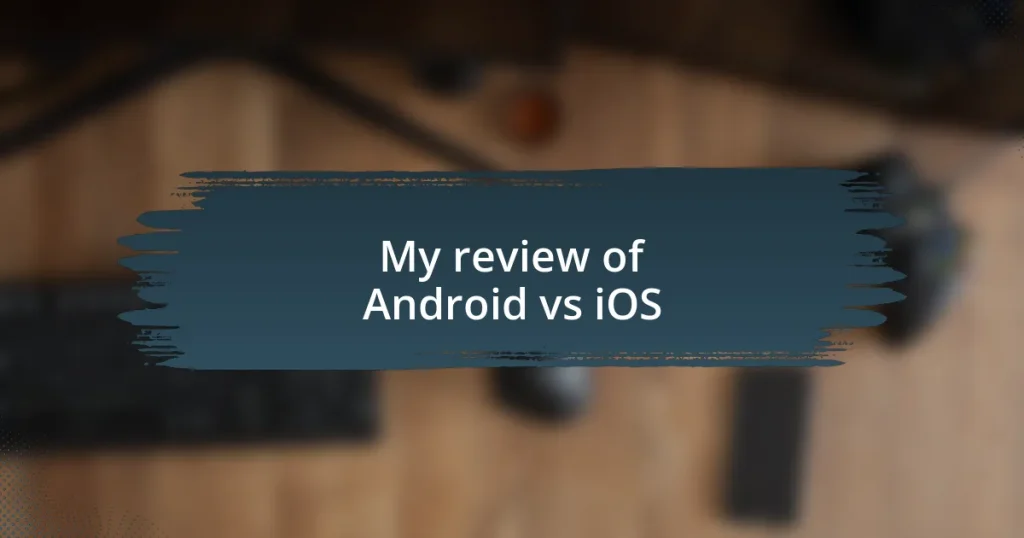Key takeaways:
- Android offers extensive customization and a wide range of hardware options, while iOS emphasizes a user-friendly interface and security.
- App quality tends to be higher on iOS, with developers prioritizing polished releases, while Android provides more diverse and niche app selections.
- iOS assures consistent security updates and privacy protections, whereas Android’s variety of apps can lead to inconsistent security practices.
- User experiences differ significantly, with Android users valuing customization and flexibility, while iOS users appreciate seamless integration and predictability.
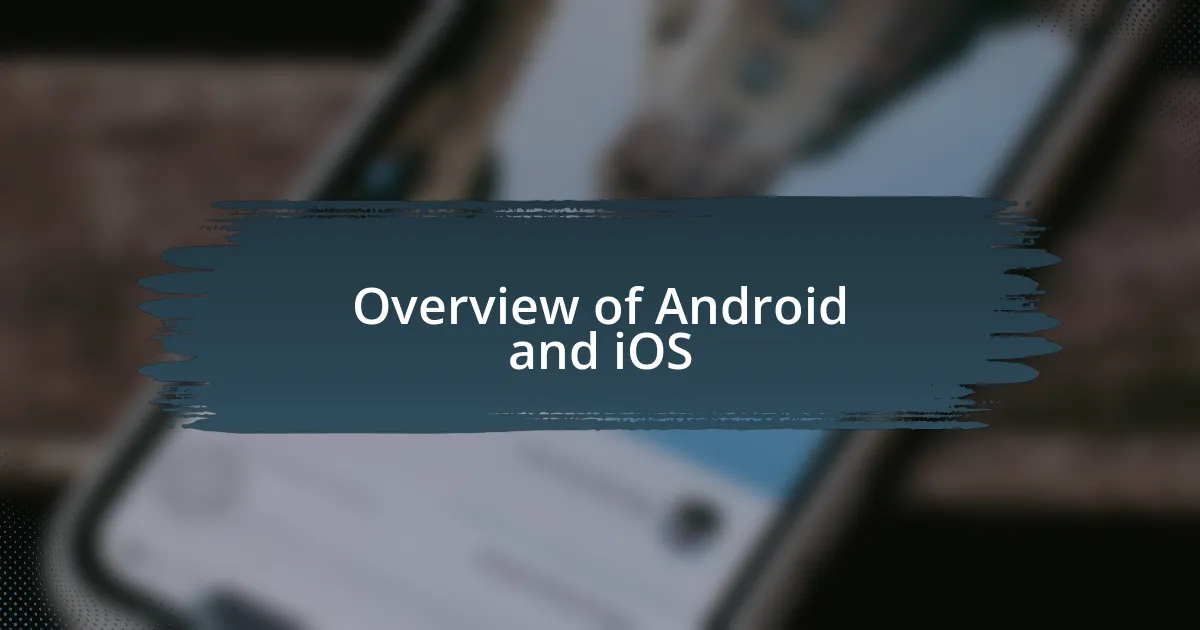
Overview of Android and iOS
Android and iOS represent two distinct philosophies in mobile operating systems. Android, with its open-source nature, offers users extensive customization options, allowing me to tailor my device to fit my personal style. On the flip side, iOS presents a more controlled environment, prioritizing security and user experience, which often feels seamless but can also feel limiting at times.
Whenever I switch between Android and iOS devices, I notice how each platform has its strengths and quirks. For instance, I love the robustness of Android’s widget system that allows me quick access to information right from my home screen, but I’ve sometimes felt frustrated by the fragmentation across different manufacturers. Do you ever feel torn between the freedom of Android and the polish of iOS? It’s a dilemma many users grapple with as both platforms have their unique charm.
Another significant difference lies in app ecosystems; developers often prioritize iOS for more polished releases. This has led me to come across certain apps that feel more intuitive and better integrated on iOS, even if I appreciate the range of alternatives available on Android. Have you ever downloaded an app that just didn’t work as perfectly on one platform as it did on the other? These experiences can shape our preferences and play a pivotal role in which operating system we choose to embrace as our daily driver.

Key Features of Android
Key Features of Android
When it comes to customization, Android truly shines. I remember the first time I set up my Android phone, and it felt like creating my own digital environment. From changing launchers to modifying widgets, the ability to personalize my device was exhilarating. Does it feel like freedom to you? It sure did for me.
Another standout feature is the integration of Google services. As a long-time Google user, I appreciate how Android seamlessly ties in applications like Gmail, Google Drive, and Google Assistant. This ecosystem creates a coherent experience, making my workflow smoother. I often find myself using voice commands to set reminders or get directions, which saves me so much time. Have you ever considered how these conveniences impact your daily routine?
Additionally, the variety of hardware available with Android devices is impressive. From budget-friendly options to high-end smartphones, there’s something for everyone. I remember buying an affordable Android phone that still delivered a solid performance, allowing me to experience quality without breaking the bank. This flexibility is something I think many users appreciate—having the option to choose based on personal needs and budgets can make all the difference.
| Feature | Description |
|---|---|
| Customization | Extensive options allow users to personalize their devices |
| Google Integration | Seamless use of Google apps enhances daily tasks |
| Hardware Variety | A wide range of devices cater to different users and budgets |
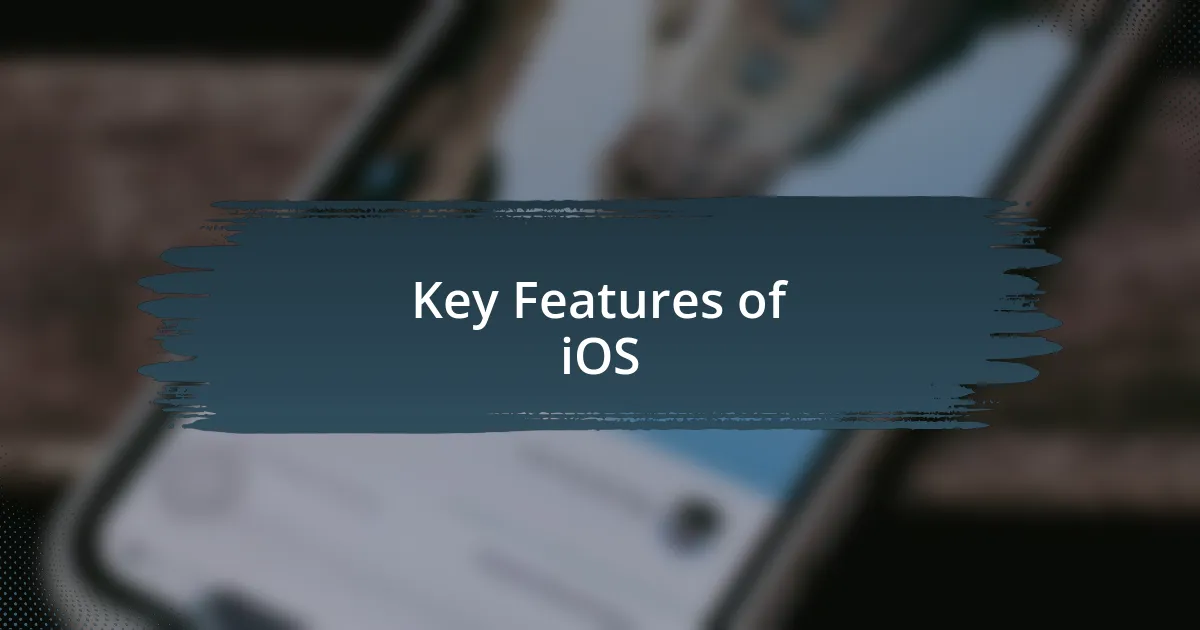
Key Features of iOS
Key Features of iOS
Key Features of iOS
One feature that instantly struck me when I first explored iOS was its user-friendly interface. Everything is smooth and intuitive, making it easy to navigate through apps and settings. I recall how quickly I adapted to the layout, and I think that’s a testament to Apple’s focus on simplicity. For anyone who values a seamless experience, this is a noteworthy aspect.
Another key aspect is the strong emphasis on security and privacy. I remember feeling relieved knowing that my personal information was well protected. Apple has made a commitment to prioritize user privacy, implementing features like App Tracking Transparency, which gives users more control over how their data is shared. This level of protection is something that resonates with many of us who are increasingly concerned about digital privacy.
- User-friendly Interface: Intuitive design allows for effortless navigation.
- Security and Privacy: Strong protections like App Tracking Transparency to safeguard user data.
- Timely Software Updates: Regular updates ensure devices receive the latest features and security enhancements.
- Ecosystem Integration: Seamless interaction between devices, like iPhones, iPads, and Macs, enhances overall usability.
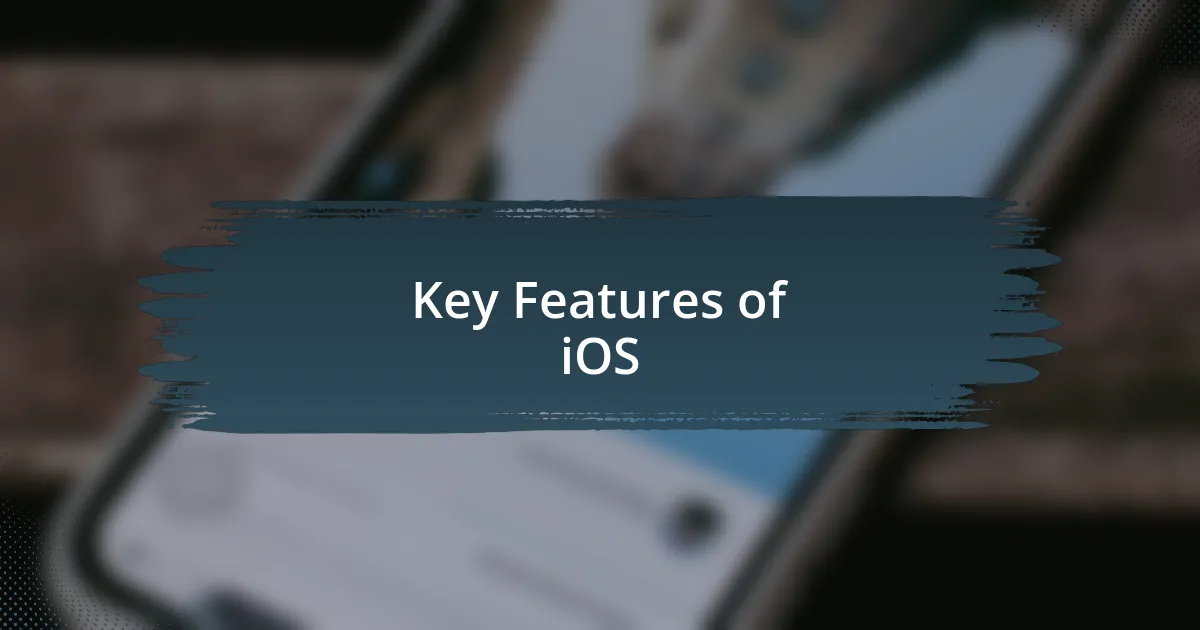
User Experience Comparison
When I switched to Android for the first time, one of the things that caught my attention was the level of customization it offered. I vividly remember spending hours tweaking my home screen, changing widgets, and even selecting different launchers. It felt empowering to tailor my device to match my personal aesthetic and functionality preferences. Isn’t it refreshing to have that kind of creative control?
In contrast, iOS provides a more uniform user experience, which can be refreshing but also limiting. I noticed that iPhone users often value the predictability of their interface, but I sometimes found it stifling. There’s a certain comfort in knowing what to expect, but I wondered if some users missed the excitement of personalizing their devices.
The responsiveness of both systems can also vary significantly. I’ve observed that while iOS typically offers consistent performance, certain Android models can slow down over time, especially if packed with apps. This experience with lag can be frustrating, particularly when you’re trying to multitask. Doesn’t it make a difference when your device keeps up with your pace?
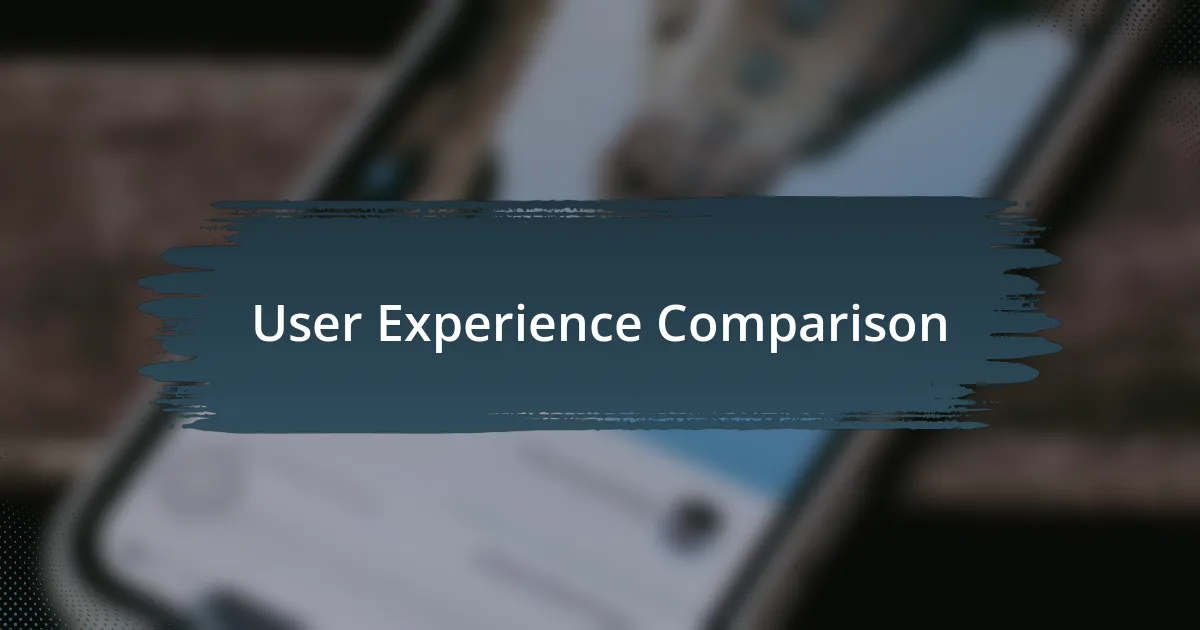
App Ecosystem Analysis
App Ecosystem Analysis
When exploring the app ecosystems of Android and iOS, I found a world of diversity on Android that can be quite exhilarating. With countless apps available, I often stumble upon unique offerings that cater to niche interests. For instance, I discovered a budgeting app that wasn’t available on iOS, which turned out to be a game changer for my financial tracking. Have you ever found that one app that just clicks with your daily routine?
Conversely, iOS tends to prioritize quality over quantity in its app selection. I’ve noticed that many of the popular apps on iOS are more polished and user-friendly. The first time I downloaded an app on my iPhone, I was struck by the seamless integration with the iOS environment. It felt like everything was designed to work in harmony, which is something I deeply appreciate. How often do we underestimate the value of a smooth user experience?
Furthermore, the constant updates in both ecosystems can influence app performance and security. I remember an instance when a critical update turned my go-to Android app into a clunky experience. On the other hand, iOS updates often come with enhanced privacy features, making me feel more secure while using various applications. Isn’t it interesting how your choice of operating system can affect not just the apps themselves, but also your overall peace of mind?
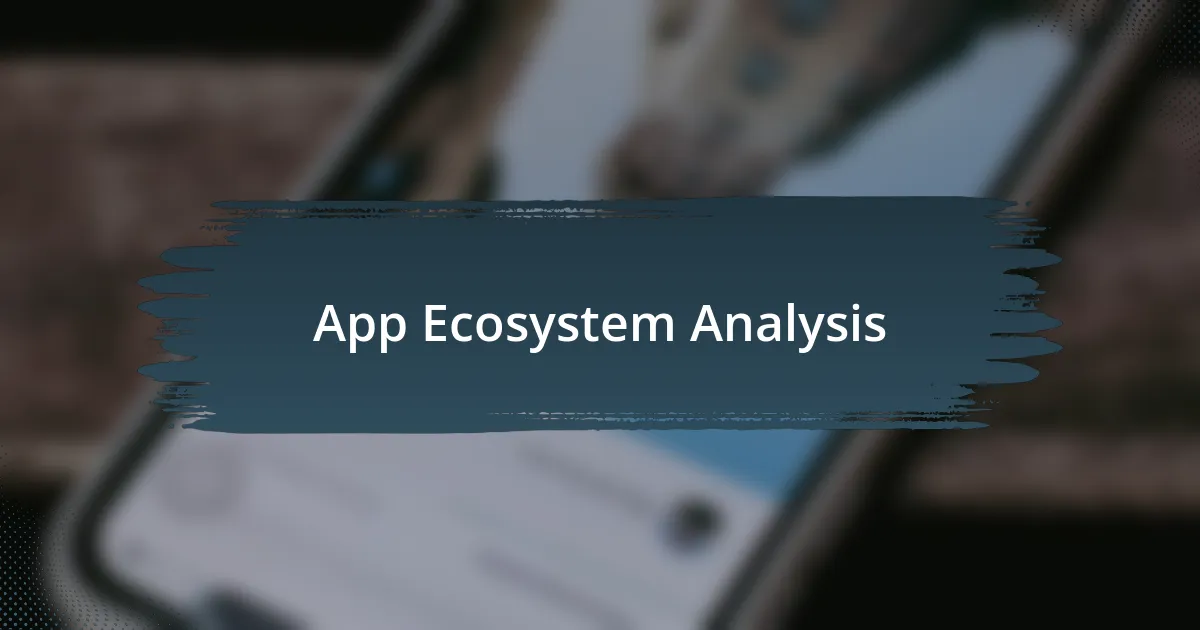
Security and Privacy Considerations
When it comes to security and privacy, I really feel there’s a noticeable gap between Android and iOS. While using my Android device, I was impressed by the variety of security apps available, but this plethora also meant that not every app was vetted properly. Once, I downloaded a third-party app that promised to enhance my privacy, only to realize later that it had access to far more data than necessary. Have you ever had that uneasy feeling after realizing an app wasn’t as trustworthy as it claimed?
On the flip side, my experience with iOS has been more reassuring in terms of privacy. Apple’s focus on protecting user data is evident in their consistent privacy updates and features like App Tracking Transparency. I distinctly remember a moment when I was prompted to allow an app to track my activity, and it felt empowering to choose no without hesitation. Isn’t it fascinating how tools designed to protect privacy can shift our mindset about sharing personal information?
Moreover, while discussing security, I’ve noticed that iOS devices tend to have a more uniform update process, which significantly reduces vulnerabilities. After an update on my iPhone, I often find myself feeling a sense of relief, knowing that my personal data is better shielded. Have you experienced that comforting sensation when your device tells you it’s fully updated and secured?











